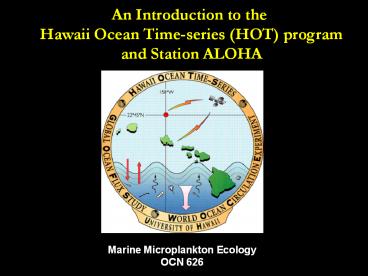An Introduction to the PowerPoint PPT Presentation
Title: An Introduction to the
1
An Introduction to the Hawaii Ocean Time-series
(HOT) program and Station ALOHA
Marine Microplankton Ecology OCN 626
2
- One of the required assignments for OCN 626 is
for each of you to give a talk (12 minutes) and
write a report on a microbially-relevant aspect
of the HOT program. - Some examples
- Dynamics of primary production
- A comparison of plankton biomass at Station ALOHA
and at BATS (Sargasso Sea) - Temporal variability in the diversity of
photosynthetic plankton
3
HOT and Station ALOHA
- Hawaii Ocean Time series (HOT) began as a central
component of the Joint Global Ocean Flux Study in
1988. - Continuous time series record of biogeochemical
and physical oceanographic properties at study
site Station ALOHA - (2245N, 158W)
- Station ALOHA is occupied for 1 week every month
4
Historical Highlights Leading to HOT
1979 Coastal Zone Color Scanner (CZCS) is launched
October 1988 First research cruise to Station
ALOHA (A Long-term Oligotrophic Habitat
Assessment)
1986-1988 Vertical Transport and Exchange
(VERTEX) program
August 2008 204 Cruises to Station ALOHA
1961 Menzel and Ryther publish 3 years of
biogeochemical measurements at Station S
1987 Global Ocean Flux Study begins
December 1998 100 cruises to Station ALOHA
1976 Keeling publishes 18 year record of
atmospheric CO2 measurements at Mauna Loa, Hawaii
1988 US National Science Foundation grants to D.
Karl (U. Hawaii) and A. Knap (BBSR) for
establishment of two deep-ocean time series
stations (HOT and BATS)
1954 Stommel and Sutcliffe begin bimonthly
measurements at Hydrostation S 28 km SE of
Bermuda
James Watt
5
Station ALOHA and the North Pacific Subtropical
Gyre (NPSG)
ALOHA
NPSG 15N to 35N 135E to 135W One of the
largest ecosystems on the planet
NPSG
Station ALOHA 4800 m deep
6
HOT
BATS
7
Characteristic features of the subtropical gyre
habitats
- Very low nutrient concentrations
- Light penetrates deep into the upper ocean
- Deep chlorophyll maximum
- Small plankton
- Very rapid nutrient recycling
- Very important to global carbon cycle (by virtue
of their enormous size)
8
(No Transcript)
9
Objectives of the HOT program (circa 1996)
- Understand seasonal and interannual variability
in rates of production and particle export. - Determine the mechanisms and rates of nutrient
input and recycling in the upper 200 m of the
water column. - Measure time varying concentrations of CO2 in the
upper ocean and estimate annual air-sea gas fluxes
10
(No Transcript)
11
HOT Program Highlights(specific to marine
microbiology)
- Bacteria are predominate photosynthetic organisms
(Prochlorococcus and Synechococcus). - Climate-dependence to plankton biomass and
productivity. - Higher than anticipated rates of primary
production - (gt 14 mol C m-2 yr-1).
- Archaea numerically dominate mesopelagic (gt 200
m) plankton assemblages.
12
HOT-DOGS
- Data Types
- CTD Seabird sensor package
- Bottle 24-place rossette and 12L niskin bottles
- Particle Flux floating sediment traps
- Primary Production in-situ incubated 14C
- Data Modules
- Data Extraction text columns of data
- Display vertical profiles
- Standard Depths summary comparative plots
- Time-Series integral, means horizons
13
Partial list of microbially-relevant measurements
at Station ALOHA
- Temperature, Salinity, Density
- dissolved O2, dissolved inorganic carbon, pH
- Dissolved inorganic nutrients (nitrate, nitrite,
phosphorus, silica) - Particulate nitrogen, carbon, and phosphorus
- Pigments
- Primary production
- Various measures of plankton biomass
- Plankton cell abundances (Prochlorococcus,
Synechococcus, non-pigmented picoplankton). - Particle export (carbon, nitrogen, phosphorus
fluxes)
14
A few ideas for topics
- Variability in primary production at Station
ALOHA - Data sets available 14C-bicarbonate assimilation
rates, changes in O2 - A comparison of plankton biomass and
productivity at Station ALOHA and BATS - Data sets available bacterial cell abundances,
chlorophyll, primary production, etc. - Temporal variability in the diversity and
biomass of photosynthetic plankton - Data sets available HPLC pigment concentrations,
flow cytometric cell abundances
15
http//hahana.soest.hawaii.edu/hot/hot-dogs/interf
ace.html

